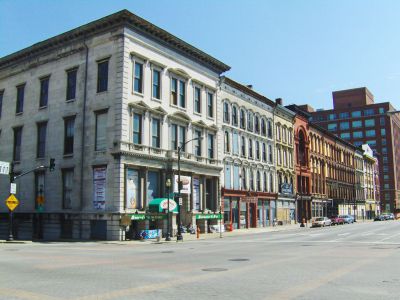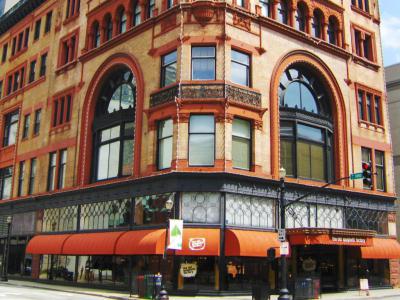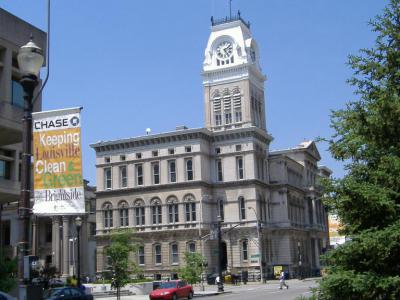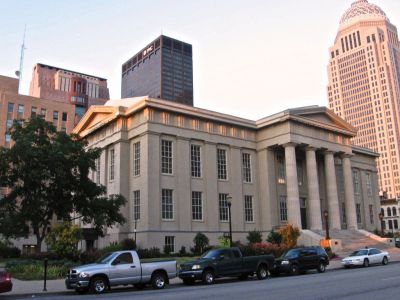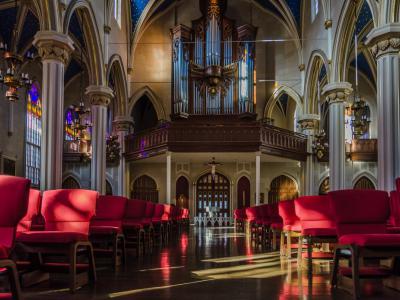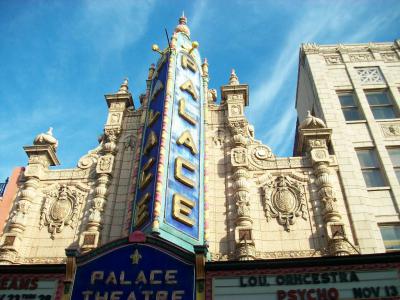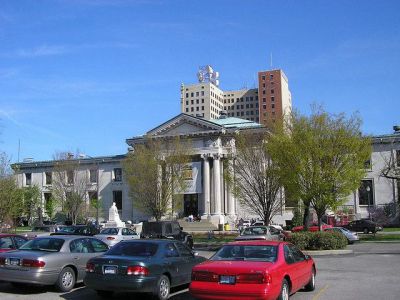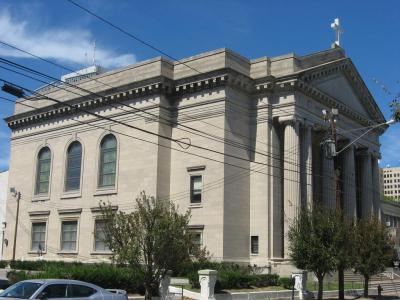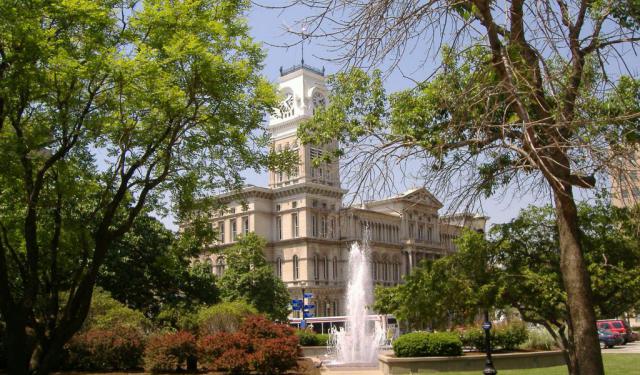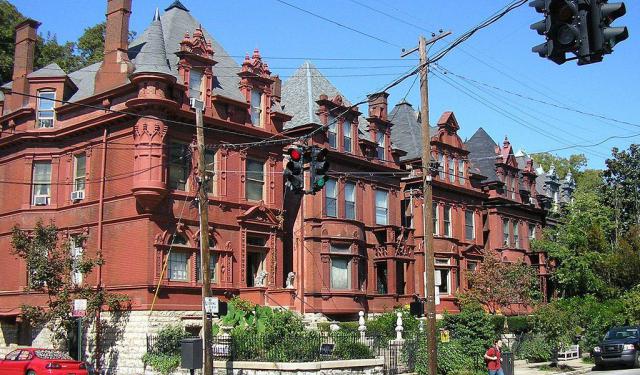Louisville Architecture Walking Tour (Self Guided), Louisville
Louisville, Kentucky, is famous for its architectural marvels, featuring a combination of styles and eras, sizes and artistic directions, adding a great deal of uniqueness to the city panorama. Architecture buffs will be delighted at a chance to admire the elaborate edifices abounding the city.
One such iconic spot is Whiskey Row. Once a bustling hub of the local bourbon industry, it has been transformed from a collection of historic Revivalist and Chicago School-style structures into a renovated district with luxury apartments, restaurants, and retail businesses, solidifying its status as a National Landmark.
The Old Bank of Louisville stands as a testament to the city's financial history, with its grand neoclassical design and imposing columns. Nearby, the Levy Building is a prime example of Richardsonian Romanesque architecture, boasting historical significance as one of Louisville's earliest buildings fitted with electricity.
City Hall and Metro Hall are prominent examples of civic construction of the 1800s. The former embodies a striking fusion of Italianate, Second Empire, Beaux Arts, and Romanesque Revival styles, reflecting the city's post-Civil War optimism, while the latter, constructed to architect Gideon Shryock's design, earned both praise and criticism and eventually gained recognition on the National Register of Historic Places.
Religious architecture also plays a significant role in Louisville's landscape. The Cathedral of the Assumption is a fine example of Gothic Revival, with its towering spire and high-vaulting ceiling, whereas the Greater Bethel Temple in Old Louisville, originally the church constructed in Classical Revival, features a Bedford Limestone facade adorned with six grand columns supporting a portico.
The Palace Theatre is a historic music venue with Spanish Baroque architecture, adorned with intricate ornamentation, hosting a variety of renowned musicians since its opening in 1928. Meanwhile, the Louisville Free Public Library, established in 1908, combines Beaux-Arts design elements with functional spaces, offering innovative services like its pioneering FM radio station.
Louisville's architecture is a reflection of its diverse heritage and cultural identity. So, whether you're a local or a curious visitor, take some time to wander through the streets of Louisville and marvel at the beauty and history encapsulated in its walls. You never know what hidden gems you might discover around the next corner.
One such iconic spot is Whiskey Row. Once a bustling hub of the local bourbon industry, it has been transformed from a collection of historic Revivalist and Chicago School-style structures into a renovated district with luxury apartments, restaurants, and retail businesses, solidifying its status as a National Landmark.
The Old Bank of Louisville stands as a testament to the city's financial history, with its grand neoclassical design and imposing columns. Nearby, the Levy Building is a prime example of Richardsonian Romanesque architecture, boasting historical significance as one of Louisville's earliest buildings fitted with electricity.
City Hall and Metro Hall are prominent examples of civic construction of the 1800s. The former embodies a striking fusion of Italianate, Second Empire, Beaux Arts, and Romanesque Revival styles, reflecting the city's post-Civil War optimism, while the latter, constructed to architect Gideon Shryock's design, earned both praise and criticism and eventually gained recognition on the National Register of Historic Places.
Religious architecture also plays a significant role in Louisville's landscape. The Cathedral of the Assumption is a fine example of Gothic Revival, with its towering spire and high-vaulting ceiling, whereas the Greater Bethel Temple in Old Louisville, originally the church constructed in Classical Revival, features a Bedford Limestone facade adorned with six grand columns supporting a portico.
The Palace Theatre is a historic music venue with Spanish Baroque architecture, adorned with intricate ornamentation, hosting a variety of renowned musicians since its opening in 1928. Meanwhile, the Louisville Free Public Library, established in 1908, combines Beaux-Arts design elements with functional spaces, offering innovative services like its pioneering FM radio station.
Louisville's architecture is a reflection of its diverse heritage and cultural identity. So, whether you're a local or a curious visitor, take some time to wander through the streets of Louisville and marvel at the beauty and history encapsulated in its walls. You never know what hidden gems you might discover around the next corner.
How it works: Download the app "GPSmyCity: Walks in 1K+ Cities" from Apple App Store or Google Play Store to your mobile phone or tablet. The app turns your mobile device into a personal tour guide and its built-in GPS navigation functions guide you from one tour stop to next. The app works offline, so no data plan is needed when traveling abroad.
Louisville Architecture Walking Tour Map
Guide Name: Louisville Architecture Walking Tour
Guide Location: USA » Louisville (See other walking tours in Louisville)
Guide Type: Self-guided Walking Tour (Sightseeing)
# of Attractions: 9
Tour Duration: 2 Hour(s)
Travel Distance: 2.8 Km or 1.7 Miles
Author: Cathy
Sight(s) Featured in This Guide:
Guide Location: USA » Louisville (See other walking tours in Louisville)
Guide Type: Self-guided Walking Tour (Sightseeing)
# of Attractions: 9
Tour Duration: 2 Hour(s)
Travel Distance: 2.8 Km or 1.7 Miles
Author: Cathy
Sight(s) Featured in This Guide:
- Whiskey Row
- Old Bank of Louisville
- Levy Building
- City Hall
- Metro Hall
- Cathedral of the Assumption
- Palace Theatre
- Louisville Free Public Library
- Greater Bethel Temple
1) Whiskey Row
Whiskey Row is a historically significant stretch of West Main Street in downtown Louisville, spanning addresses 101 to 133. In the late 1800s and early 1900s, this block emerged as a key center for the bourbon trade, with distilleries, warehouses, and whiskey firms densely packed into the area. Barrels of bourbon arrived by wagon or rail for sale and storage, and the sheer number of whiskey-related businesses earned the nickname “Whiskey Row.” Over time, the block became known not only for its economic role but also for its distinctive architecture, showcasing cast-iron façades in a mix of Revivalist and Chicago School styles.
The architectural significance of the block is notable-it forms one of the largest concentrations of cast-iron structures outside of New York’s SoHo, leading to the alternate name “Iron Quarter.” The buildings were designed by respected architects including John Andrewartha, Henry Whitestone, and Dennis Xavier Murphy, whose work helped define the area’s visual identity. These elements, along with the street's industrial past, contribute to Whiskey Row’s status as a tangible link to Louisville’s bourbon legacy.
In 2011, the future of Whiskey Row was in jeopardy when it appeared on the city’s list of Most Endangered Historic Places. A devastating fire in 2015 further threatened its survival, damaging several buildings. However, concerted efforts by preservationists and developers managed to restore much of the block. Today, Whiskey Row is a revitalized district that blends historical character with modern use, home to the Old Forester Distillery, restaurants, shops, and residential developments. Recognized as a National Landmark, Whiskey Row now stands not only as a tribute to Louisville’s bourbon heritage but also as a model for adaptive reuse and urban preservation.
The architectural significance of the block is notable-it forms one of the largest concentrations of cast-iron structures outside of New York’s SoHo, leading to the alternate name “Iron Quarter.” The buildings were designed by respected architects including John Andrewartha, Henry Whitestone, and Dennis Xavier Murphy, whose work helped define the area’s visual identity. These elements, along with the street's industrial past, contribute to Whiskey Row’s status as a tangible link to Louisville’s bourbon legacy.
In 2011, the future of Whiskey Row was in jeopardy when it appeared on the city’s list of Most Endangered Historic Places. A devastating fire in 2015 further threatened its survival, damaging several buildings. However, concerted efforts by preservationists and developers managed to restore much of the block. Today, Whiskey Row is a revitalized district that blends historical character with modern use, home to the Old Forester Distillery, restaurants, shops, and residential developments. Recognized as a National Landmark, Whiskey Row now stands not only as a tribute to Louisville’s bourbon heritage but also as a model for adaptive reuse and urban preservation.
2) Old Bank of Louisville
The Old Bank of Louisville, also known as the Southern National Bank Building, stands on West Main Street in downtown Louisville. Completed in 1837 and designated a National Historic Landmark in 1971, it is widely regarded as one of the finest examples of small-scale Greek Revival architecture in the United States. Originally built to house the Bank of Louisville-chartered in 1833-the building is now incorporated into the Actors Theatre of Louisville, serving as its entrance and grand lobby space.
The building’s narrow but commanding limestone façade features two fluted Ionic columns set between bold, battered piers in a distyle in antis arrangement-an ancient architectural form rarely seen in American commercial structures. Cast-iron palmette motifs crown the entablature, replacing the conventional pediment with a richly detailed parapet. Though long attributed to Gideon Shryock, who oversaw construction, the design is now firmly credited to James H. Dakin, a young New York architect whose inventive approach combined Grecian ideals with bold reinterpretations, possibly influenced by both Egyptian gateways and contemporary pattern books like The Beauties of Modern Architecture.
Inside, the main banking hall is an equally ambitious space. Ionic columns and pilasters frame a rectangular plan, crowned by an elliptical dome supported on a curving frieze-a creative break from classical norms. The central oculus, originally filled with a sky-painted skylight, evokes the Roman Pantheon and brings natural light into the dramatic interior. Behind the hall, the original layout included vaults, offices, and a rear stairwell. In 1972, architect Harry Weese transformed the structure into part of the Actors Theatre complex, seamlessly blending Dakin’s historic vision with modern performance spaces. Today, the Old Bank remains a striking architectural landmark and a vivid reminder of Louisville’s 19th-century civic ambition.
The building’s narrow but commanding limestone façade features two fluted Ionic columns set between bold, battered piers in a distyle in antis arrangement-an ancient architectural form rarely seen in American commercial structures. Cast-iron palmette motifs crown the entablature, replacing the conventional pediment with a richly detailed parapet. Though long attributed to Gideon Shryock, who oversaw construction, the design is now firmly credited to James H. Dakin, a young New York architect whose inventive approach combined Grecian ideals with bold reinterpretations, possibly influenced by both Egyptian gateways and contemporary pattern books like The Beauties of Modern Architecture.
Inside, the main banking hall is an equally ambitious space. Ionic columns and pilasters frame a rectangular plan, crowned by an elliptical dome supported on a curving frieze-a creative break from classical norms. The central oculus, originally filled with a sky-painted skylight, evokes the Roman Pantheon and brings natural light into the dramatic interior. Behind the hall, the original layout included vaults, offices, and a rear stairwell. In 1972, architect Harry Weese transformed the structure into part of the Actors Theatre complex, seamlessly blending Dakin’s historic vision with modern performance spaces. Today, the Old Bank remains a striking architectural landmark and a vivid reminder of Louisville’s 19th-century civic ambition.
3) Levy Building
The Levy Building, prominently located at Third and Market in downtown Louisville, stands as one of the city’s finest surviving examples of Richardsonian Romanesque architecture. Designed by Charles J. Clarke and Arthur Loomis, the building opened in 1893 and gained immediate attention for its robust stonework, arched windows, and bold architectural detailing. It first appeared in the American Architect and Building News the same year, marking its place among notable U.S. constructions of the period.
Originally developed by Moses and Henry Levy to house their upscale department store, Levy Brothers Clothing Store, the building remained in commercial use for nearly 90 years until the store’s closure in 1979. It was one of the first structures in Louisville to be fitted with electric lighting, and its nighttime glow gave rise to the local expression, “lit up like Levy’s,” still remembered as a piece of urban folklore. A state historical marker now commemorates its legacy.
After a period of renovation, the building found new life. The Old Spaghetti Factory restaurant began operating on the first floor, while the upper levels were transformed into 23 residential condominiums in 2005. These units share access to a rooftop terrace, meeting spaces, and a fitness room-preserving the structure’s historical integrity while adapting it to contemporary use. Today, the Levy Building remains a landmark of architectural and cultural continuity, linking Louisville’s commercial past to its evolving downtown landscape.
Originally developed by Moses and Henry Levy to house their upscale department store, Levy Brothers Clothing Store, the building remained in commercial use for nearly 90 years until the store’s closure in 1979. It was one of the first structures in Louisville to be fitted with electric lighting, and its nighttime glow gave rise to the local expression, “lit up like Levy’s,” still remembered as a piece of urban folklore. A state historical marker now commemorates its legacy.
After a period of renovation, the building found new life. The Old Spaghetti Factory restaurant began operating on the first floor, while the upper levels were transformed into 23 residential condominiums in 2005. These units share access to a rooftop terrace, meeting spaces, and a fitness room-preserving the structure’s historical integrity while adapting it to contemporary use. Today, the Levy Building remains a landmark of architectural and cultural continuity, linking Louisville’s commercial past to its evolving downtown landscape.
4) City Hall
Louisville City Hall, constructed between 1870 and 1873, stands as one of the city’s most prominent civic landmarks. Originally built to serve as the headquarters of Louisville’s municipal government, it has since transitioned to house the offices and chambers of the Louisville Metro Council following the merger with Jefferson County. Throughout its long history, the building has remained a central symbol of local governance and civic pride.
The architecture of City Hall reflects a confident and ambitious post-Civil War Louisville, combining Italianate and Second Empire styles with elements of Beaux Arts and Romanesque Revival. A notable detail above the main entrance is the pediment relief featuring the city seal and a steam engine moving past southern foliage-emblazoned with the word “Progress” and dated 1871. Additional carvings above side windows depict livestock heads, a nod to the city’s agricultural roots.
City Hall rises three stories above a raised basement and retains much of its original exterior form. Inside, however, it has undergone extensive restoration efforts over the years. A Greco-Roman style annex was added in 1909, designed by Cornelius Curtin. The structure’s most iconic element is its 195-foot clock tower with a mansard roof, completed in 1876 after the original burned down. The tower’s three-ton bell rang until the 1960s, with several repairs attempted before it was fully restored in 1991.
Recognized for its historical and architectural significance, Louisville City Hall was added to the National Register of Historic Places in 1976. Today, it remains a distinguished fixture in downtown Louisville, reflecting both the city’s 19th-century aspirations and its continued civic role.
The architecture of City Hall reflects a confident and ambitious post-Civil War Louisville, combining Italianate and Second Empire styles with elements of Beaux Arts and Romanesque Revival. A notable detail above the main entrance is the pediment relief featuring the city seal and a steam engine moving past southern foliage-emblazoned with the word “Progress” and dated 1871. Additional carvings above side windows depict livestock heads, a nod to the city’s agricultural roots.
City Hall rises three stories above a raised basement and retains much of its original exterior form. Inside, however, it has undergone extensive restoration efforts over the years. A Greco-Roman style annex was added in 1909, designed by Cornelius Curtin. The structure’s most iconic element is its 195-foot clock tower with a mansard roof, completed in 1876 after the original burned down. The tower’s three-ton bell rang until the 1960s, with several repairs attempted before it was fully restored in 1991.
Recognized for its historical and architectural significance, Louisville City Hall was added to the National Register of Historic Places in 1976. Today, it remains a distinguished fixture in downtown Louisville, reflecting both the city’s 19th-century aspirations and its continued civic role.
5) Metro Hall
Louisville Metro Hall, originally known as the Jefferson County Courthouse, is the historic seat of government in downtown Louisville. Construction began in 1836, and by 1842, the unfinished structure was already in use by both city and county authorities. Designed by architect Gideon Shryock in the Greek Revival style, the building was initially conceived with grand elements such as a full Doric portico, a cupola, and symmetrical wing porticos. However, after Shryock's resignation in 1842, the project was scaled down under engineer Albert Fink, and it was not completed until 1860. Despite public criticism at the time, the structure went on to play key roles in city, state, and national history.
In the 1840s, the courthouse grounds witnessed both slave auctions and abolitionist speeches, reflecting Kentucky’s conflicted identity before the Civil War. During the war, it briefly served as the state capitol when Frankfort was occupied by Confederate forces. Hopes that the building would become Kentucky’s permanent capitol were dashed, earning it the nickname “Guthrie’s folly,” after politician James Guthrie. A 1905 fire prompted renovations by Brinton B. Davis, and by the mid-20th century, preservation efforts began to outweigh calls for demolition.
Listed on the National Register of Historic Places in 1972, the building is now known as Louisville Metro Hall and houses the Mayor’s Office and several judicial and administrative offices. Its grounds feature two significant statues: one of Thomas Jefferson and another of King Louis XVI, the latter gifted by Montpellier, France. The latter statue was damaged during the 2020 protests, symbolizing the evolving public dialogue around civic monuments.
In the 1840s, the courthouse grounds witnessed both slave auctions and abolitionist speeches, reflecting Kentucky’s conflicted identity before the Civil War. During the war, it briefly served as the state capitol when Frankfort was occupied by Confederate forces. Hopes that the building would become Kentucky’s permanent capitol were dashed, earning it the nickname “Guthrie’s folly,” after politician James Guthrie. A 1905 fire prompted renovations by Brinton B. Davis, and by the mid-20th century, preservation efforts began to outweigh calls for demolition.
Listed on the National Register of Historic Places in 1972, the building is now known as Louisville Metro Hall and houses the Mayor’s Office and several judicial and administrative offices. Its grounds feature two significant statues: one of Thomas Jefferson and another of King Louis XVI, the latter gifted by Montpellier, France. The latter statue was damaged during the 2020 protests, symbolizing the evolving public dialogue around civic monuments.
6) Cathedral of the Assumption
The Cathedral of the Assumption, located in the heart of downtown Louisville, is the mother church of the Roman Catholic Archdiocese of Louisville and a cornerstone of the city’s spiritual and architectural heritage. Dedicated in 1852, it was constructed as a grander successor to the earlier Saint Louis Church on the same site. Designed in the Neo-Gothic style, the Cathedral is distinguished by its pointed arches, richly carved wooden details, and striking stained-glass windows. At its heart is the majestic pipe organ, a centerpiece for religious and musical events that draws visitors and worshippers alike.
Soon after its completion, the Cathedral faced threats born from widespread anti-Catholic and anti-immigrant sentiment. In 1855, during a period of violent unrest that left 22 German and Irish immigrants dead across Louisville, the church was falsely accused of harboring weapons in its basement. It narrowly escaped destruction when Mayor John Barbee-himself affiliated with the nativist "Know-Nothing" movement-personally inspected the premises and dismissed the claims.
Over the years, the Cathedral underwent numerous renovations to preserve and adapt the historic structure. Major renovations began in 1988, culminating in a fully restored undercroft in 1991 and a two-year renovation of the main worship space completed in 1994. The Cathedral spire and bell tower were also restored in 1998, marking the completion of a transformative preservation effort.
Today, the Cathedral complex has grown into a vibrant urban campus. In addition to the main sanctuary and Eucharistic chapel, the grounds include the Cathedral undercroft, Saint Louis Hall, the Sandefur Dining Room-which serves the homeless-the Patterson Education Center, parish offices, and the rectory that houses the Archbishop and clergy. It serves as both a place of worship and a hub for compassion, learning, and interfaith dialogue, honoring its 19th-century legacy today.
Soon after its completion, the Cathedral faced threats born from widespread anti-Catholic and anti-immigrant sentiment. In 1855, during a period of violent unrest that left 22 German and Irish immigrants dead across Louisville, the church was falsely accused of harboring weapons in its basement. It narrowly escaped destruction when Mayor John Barbee-himself affiliated with the nativist "Know-Nothing" movement-personally inspected the premises and dismissed the claims.
Over the years, the Cathedral underwent numerous renovations to preserve and adapt the historic structure. Major renovations began in 1988, culminating in a fully restored undercroft in 1991 and a two-year renovation of the main worship space completed in 1994. The Cathedral spire and bell tower were also restored in 1998, marking the completion of a transformative preservation effort.
Today, the Cathedral complex has grown into a vibrant urban campus. In addition to the main sanctuary and Eucharistic chapel, the grounds include the Cathedral undercroft, Saint Louis Hall, the Sandefur Dining Room-which serves the homeless-the Patterson Education Center, parish offices, and the rectory that houses the Archbishop and clergy. It serves as both a place of worship and a hub for compassion, learning, and interfaith dialogue, honoring its 19th-century legacy today.
7) Palace Theatre
The Palace Theatre, also known locally as the Louisville Palace, is a historic music venue located in downtown Louisville. Originally opened on September 1, 1928, as the Loew’s and United Artists State Theatre, it was designed by architect John Eberson in his signature atmospheric style. With a seating capacity of 2,800, the venue occupies a prime spot in the city’s theater district on Fourth Street and is currently owned by Live Nation.
The theatre’s design features a Spanish Baroque motif, with ornate arcades, balconies, and turrets. The rich color palette-cobalt blue, deep red, and gold-illuminates the building’s niches and entrances, while the vaulted ceiling above the main hall resembles a night sky, dotted with 139 sculpted faces of historical figures. Inside, visitors encounter a dramatic, heavily adorned space spanning two levels, each with full-length bars connected by a grand, elaborately decorated lobby.
After years of wear, the Palace was re-dedicated in 1994 and has since regained its status as a premier live performance venue. Its distinctive interior has made it a sought-after location for live concert recordings by artists such as Alison Krauss and Third Day and even a 1983 broadcast by A Flock of Seagulls.
Over the decades, the Palace has hosted a wide spectrum of performers, from legends like Frank Sinatra and Ray Charles to Kentucky natives like My Morning Jacket and Jack Harlow. Blending architectural grandeur with cultural relevance, the Louisville Palace remains a beloved and iconic part of the city's artistic landscape.
The theatre’s design features a Spanish Baroque motif, with ornate arcades, balconies, and turrets. The rich color palette-cobalt blue, deep red, and gold-illuminates the building’s niches and entrances, while the vaulted ceiling above the main hall resembles a night sky, dotted with 139 sculpted faces of historical figures. Inside, visitors encounter a dramatic, heavily adorned space spanning two levels, each with full-length bars connected by a grand, elaborately decorated lobby.
After years of wear, the Palace was re-dedicated in 1994 and has since regained its status as a premier live performance venue. Its distinctive interior has made it a sought-after location for live concert recordings by artists such as Alison Krauss and Third Day and even a 1983 broadcast by A Flock of Seagulls.
Over the decades, the Palace has hosted a wide spectrum of performers, from legends like Frank Sinatra and Ray Charles to Kentucky natives like My Morning Jacket and Jack Harlow. Blending architectural grandeur with cultural relevance, the Louisville Palace remains a beloved and iconic part of the city's artistic landscape.
8) Louisville Free Public Library
The Louisville Free Public Library (LFPL), founded in 1902 and officially opened to the public in 1908, is the largest public library system in Kentucky. It began by merging with the Polytechnic Society of Kentucky, initially housing its collection in the Kaufman-Straus Building before moving into the purpose-built Main Library, completed in 1906. The system quickly expanded, both in physical space and social impact. Among its most historically significant achievements was the establishment of the Western Colored Branch, the first Carnegie-funded library in the U.S. built exclusively for African Americans. It was led by Thomas Fountain Blue, a pioneering figure in African American library services and training.
LFPL’s Main Library, located at 4th and York Streets in downtown Louisville, remains the central hub of the system. Its original South Building was designed by New York firm Tachau and Pilcher and funded by Andrew Carnegie. In 1969, the library expanded with the addition of a modern North Building by Louisville architects Louis and Henry, increasing total floor space from 42,000 to 152,000 square feet. This expansion reflected LFPL’s commitment to meeting the growing needs of the community.
At its peak, the LFPL system operated over 30 branches, but many were later closed due to financial constraints. Today, LFPL maintains 16 branches alongside the Main Library, continuing to serve Jefferson County with internet access, inter-library loan services, and community programming. A notable innovation came in 1950 when LFPL became the first library in the nation to launch its own FM radio station, WFPL.
LFPL’s Main Library, located at 4th and York Streets in downtown Louisville, remains the central hub of the system. Its original South Building was designed by New York firm Tachau and Pilcher and funded by Andrew Carnegie. In 1969, the library expanded with the addition of a modern North Building by Louisville architects Louis and Henry, increasing total floor space from 42,000 to 152,000 square feet. This expansion reflected LFPL’s commitment to meeting the growing needs of the community.
At its peak, the LFPL system operated over 30 branches, but many were later closed due to financial constraints. Today, LFPL maintains 16 branches alongside the Main Library, continuing to serve Jefferson County with internet access, inter-library loan services, and community programming. A notable innovation came in 1950 when LFPL became the first library in the nation to launch its own FM radio station, WFPL.
9) Greater Bethel Temple
Located in Old Louisville, the Greater Bethel Temple is a historic Pentecostal Apostolic church with roots in both architectural and spiritual heritage. The building originally housed the Adath Israel congregation and was designed by J.F. Sheblessy and Kenneth McDonald of the architectural firm McDonald and Dodd. Completed and dedicated in 1906, the structure showcases the Classical Revival style and features a stately Bedford limestone façade, with six monumental columns supporting a portico inscribed with a religious message.
Today, Greater Bethel Temple stands as a vibrant center of worship under the leadership of Bishop Rader Johnson, PhD, and First Lady Rhoda Johnson. The church emphasizes a message of holiness and spiritual growth, offering a welcoming, family-oriented atmosphere. Weekly activities include in-person and online services, Bible classes, and youth programs, as well as ministries focused on music, outreach, and missions. Children and teens can participate in age-appropriate groups, choirs, and Sunday learning sessions.
In addition to its local outreach, Greater Bethel Temple supports international ministry efforts, including aid for the Dominican Republic, and offers educational resources like the Apostolic Bible Class Notes. With over a century of continuous service, the church blends tradition with modern engagement, embracing a mix of musical styles-from traditional hymns to contemporary praise-and fostering community through fellowship, teaching, and prayer.
Greater Bethel Temple remains committed to spreading the Gospel and offering a spiritual home for all who seek a deeper relationship with God, anchored in scripture and sustained by the community.
Today, Greater Bethel Temple stands as a vibrant center of worship under the leadership of Bishop Rader Johnson, PhD, and First Lady Rhoda Johnson. The church emphasizes a message of holiness and spiritual growth, offering a welcoming, family-oriented atmosphere. Weekly activities include in-person and online services, Bible classes, and youth programs, as well as ministries focused on music, outreach, and missions. Children and teens can participate in age-appropriate groups, choirs, and Sunday learning sessions.
In addition to its local outreach, Greater Bethel Temple supports international ministry efforts, including aid for the Dominican Republic, and offers educational resources like the Apostolic Bible Class Notes. With over a century of continuous service, the church blends tradition with modern engagement, embracing a mix of musical styles-from traditional hymns to contemporary praise-and fostering community through fellowship, teaching, and prayer.
Greater Bethel Temple remains committed to spreading the Gospel and offering a spiritual home for all who seek a deeper relationship with God, anchored in scripture and sustained by the community.
Walking Tours in Louisville, Kentucky
Create Your Own Walk in Louisville
Creating your own self-guided walk in Louisville is easy and fun. Choose the city attractions that you want to see and a walk route map will be created just for you. You can even set your hotel as the start point of the walk.
Louisville Introduction Walking Tour
Poised on the banks of the Ohio River, Kentucky's largest city Louisville blends small-town charm with urban sophistication. The first European settlement in the vicinity of modern-day Louisville was on Corn Island, established in 1778 by Col. George Rogers Clark, credited as the founder of the city. Two years later, the Virginia General Assembly approved the town charter of Louisville. The... view more
Tour Duration: 2 Hour(s)
Travel Distance: 4.5 Km or 2.8 Miles
Tour Duration: 2 Hour(s)
Travel Distance: 4.5 Km or 2.8 Miles
Historical Old Louisville Walking Tour
The third largest urban district in the United States and the country's largest preservation district of Victorian-era buildings, the Old Town of Louisville is an ideal area in which to travel through the city's history. It is here that Louisville's oldest and most peculiar houses and other reminders of the past are concentrated, featuring a wealth of architectural styles.
... view more
Tour Duration: 1 Hour(s)
Travel Distance: 2.2 Km or 1.4 Miles
... view more
Tour Duration: 1 Hour(s)
Travel Distance: 2.2 Km or 1.4 Miles
The Most Popular Cities
/ view all



